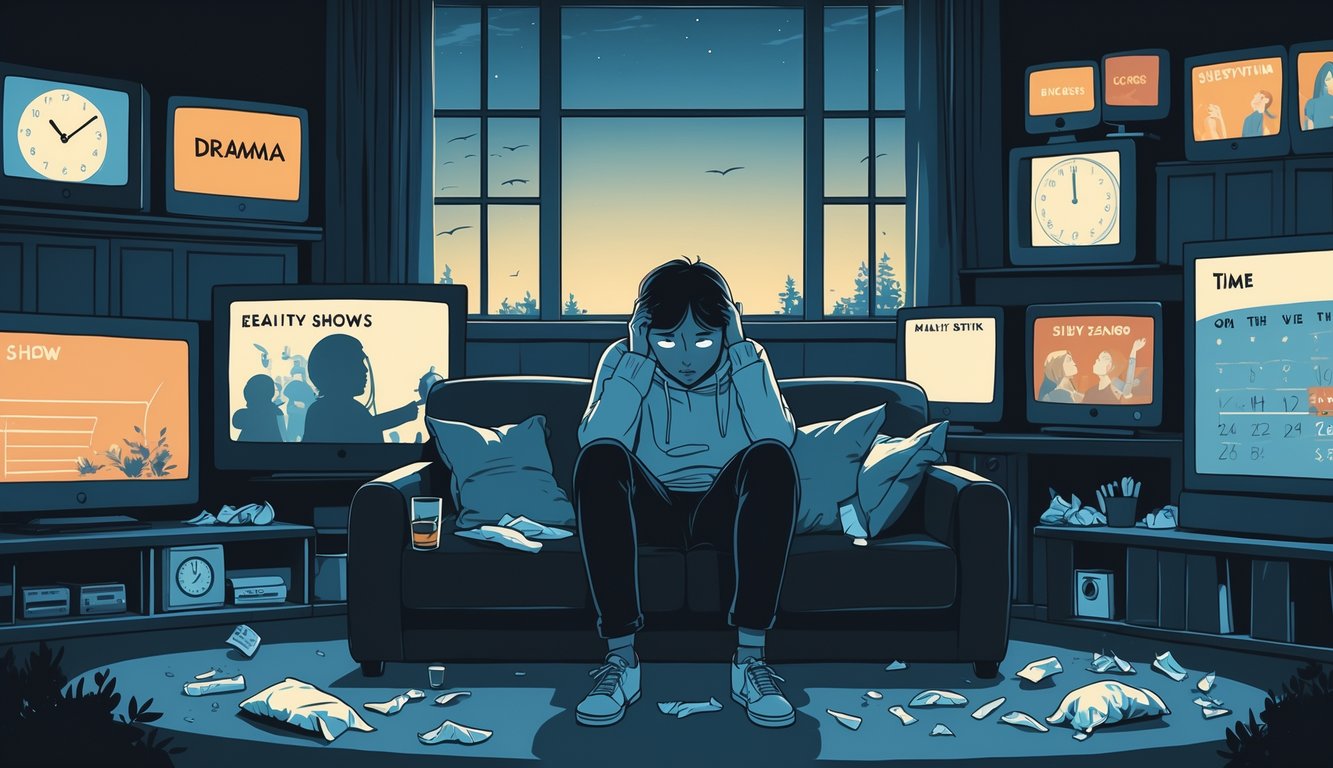
Social and Lifestyle Costs of Excessive Viewing

Honestly, after bombing my “no binge” goals last week, I’m just annoyed at how these endless sessions trash everything else. My couch has a permanent dent. Real-life drama’s never as tidy as TV, and my “just one episode” lie has cost me entire weekends.
Isolation and Relationship Strain
Every time I tell myself “one more won’t hurt,” I ghost texts and bail on plans. My social life? Shrinking, and not even in a cool, mysterious way. Exelmans and Van den Bulck (2017) called this out in their sleep and well-being study; the more I watch, the less I bother with actual people. Tried movie nights to fix it, but let’s be real—everyone just zones out on their own screens, barely talking. My therapist once said, “You can’t multitask connection.” She was right. Partners notice when you’re not really there. Fights over screen time? Been there. My friends literally had to ban phones at hangouts to get a conversation going. It’s that bad.
Effects on Daily Productivity
Those viewing apps love to brag: “Congrats, you watched 12 hours this week!” Like I need the reminder. I already blew off laundry. Some U.S. survey says over half of adults under 45 spent evenings binge-watching instead of finishing even one task. Want a tip? Set an alarm after one episode. Does it work? Never, not if the plot twists at midnight. Bosses notice the Zoom fatigue. Deadlines? Collateral damage. I forget if I ate lunch or just imagined it. My workouts? Obliterated by the “just one more” trap. TV characters solve everything by the credits. Meanwhile, I’m still staring at dirty dishes.
Economic Considerations: Subscriptions and Hidden Fees
If you think you’re paying for one streaming service, you’re not. Tiny charges, random “premium” add-ons—my bank statement looks like a graveyard of $7.99s and “limited time” offers. I keep telling myself it’s just $12.99 a month. Lies.
Comparing Streaming Services Costs
Ever notice your fourth “free trial” for Hulu morphs into that pricey ad-free plan—again? Same. Look at this table I slapped together in a panic:
| Service | Base Price (monthly) | Ad-Free Upgrade | Number of Streams | Typical Hidden Fees |
|---|---|---|---|---|
| Netflix | $15.49 | Included | 2-4 | 4K/extra profiles add-ons |
| Hulu | $7.99 | +$11 (ad-free) | 2 | DVR add-ons, premium channel bundles |
| Amazon Prime | $14.99 | Included | 3 | Rentals not included in Prime |
| Cable TV* | $65+ | N/A | Varies | Equipment rental, regional sports |
*From Investopedia: average household juggles 3-4 subscriptions, which ends up costing more than cable. Tried using all my streams at once—someone always yells about SpongeBob buffering. Not worth it.
People say, “Just rotate subscriptions!” Sure. Until you cancel Netflix and they drop a new season of the one show your friends won’t shut up about.
Promotional Pricing and Long-Term Expenses
Nobody actually warns you when that $1.99 intro deal disappears. My bank hates me for forgetting to set reminders. After the “special” period, prices just jump. Sometimes you get a heads-up, but it’s buried in an email you deleted with the rest of the junk.
This promo pricing article says most people underestimate streaming costs by 30%. Checks out. Amazon Prime claims to include music, groceries, whatever—but then I’m still paying extra for movies. Hulu’s “upgrades” sneak in a few more bucks every time I blink.
Trying to budget for streaming? Feels like Tetris, except the blocks multiply and you always lose. Ever try to cancel cable? They act like you’re breaking their heart. I still have three streaming bills on autopay because I missed the fine print. Not proud.
Advertising and Monetization Within Binge Culture
Regret hitting “next episode” for the fourth time? Advertising hasn’t disappeared—it’s just mutated. Now it’s in your face but somehow “subtle,” like the hero’s phone that’s always perfectly angled. Or those “suggested products” that pop up everywhere. I swear, TV monetization is sneakier than ever.
Subtle In-Show Advertising
Why does every tense scene feature a soda bottle? Not a coincidence. A 2023 Nielsen report (didn’t know they still did this) says the top streaming shows average 12+ brand integrations per season. Sometimes it’s a Diet Coke, sometimes it’s an SUV that’s weirdly clean during an apocalypse. My old media prof said these are all contractual—he used to negotiate them, apparently.
Dialogue always gets clunky when someone has to praise their streaming device or flex their sneakers. There’s a UCLA Anderson Review study about how in-show branding just burns people out. Subtlety’s dead. And so’s my ability to pretend I’m not being sold to every five minutes.
Sponsored Content and Endorsements
Anyone actually believe the star “just happens” to post about their favorite cold brew after filming? Paid posts, influencer tie-ins, sweepstakes—Hulu and Netflix bake ads into everything. Sometimes the ad’s the plot. Sometimes it’s an email at midnight. You can’t escape.
I’ve worked in digital marketing. Sponsorships just mutated to survive ad-skipping. Revidd’s blog explains how brands now use QR codes in episode seven for “exclusive” content, or have the cast live-tweet about taco shells. It’s kind of hilarious—until every character’s wardrobe matches a retail campaign. Coincidence? No way. Next binge, I might count the “spontaneous” endorsements. Or maybe I’ll just stop noticing.



